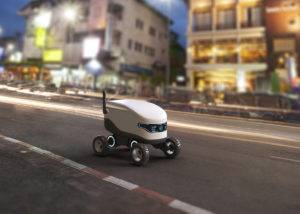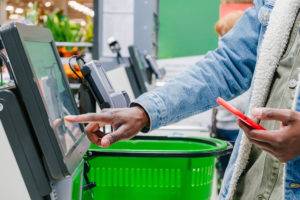
SMEG Customer Case Study
Download this data sheet to explore the features and benefits of Naveo Commerce for Enterprise Grocery.
Localised hubs for grocery, dark stores and digitally managed warehouses are not a thing of the future. As Mel Tymm, Industry Principal at Naveo Commere, explains – retailors will need to look at technologies of the present to curb their spending; keep up with competitors, and offer a seamless solution for their online customers.
by Mel Tymm (Industry Principal, Naveo Commerce)
Ease and convenience through fast, flexible and configurable delivery, is central to positive retail experience. The supply chain and retail warehouse plays a major role in supporting this experience.
It has never been more important to optimise processes and streamline management – from purchase, to package and then order fulfilment. Yet, with digital transformation still at the forefront of everyone’s minds, warehousing is changing. What can we expect from the warehouse of the future?
Retailers are beginning to understand the need to be as close to the consumer as possible. They know to serve customers who continue to expect next day or even same day delivery. Adopting micro-fulfilment approaches served by small and local Distribution Centres (DCs) will become central to delivery processes in the coming years.
Not only does fast delivery mean a more satisfied customer. Local DCs can significantly reduce costs for retailers when factored in as part of an overarching warehouse solution. Local hubs serve a smaller radius of customers within their towns or cities. This is compared to a typical, large-scale warehouse that delivers country-wide and gives both the retailor and customer choice for delivery options.
This means the last mile can be optimised and fleets will become far more sustainable by avoiding long, repeat journeys. Locations can be multi-tenanted, with the help of a third-party logistics partner. This lowers costs and allows retailers to benefit from economies of scale.
Furthermore, retailors who meet rising customer expectations with sharpened last mile solutions will ultimately lead to a great customer experience. There is no greater marketing than customer loyalty and positive word of mouth.
In order for micro-fulfilment to work successfully, retailers must consider logistical challenges. Plus, the need for integrated technologies to ensure a clear supply chain, with multiple warehouses and stores, and differing stock levels. An Order Management System (OMS) should constantly communicate with the front-end eCommerce system. This way, customer disappointment caused by incorrect stock information is avoided.
With total visibility, control and communication, comes seamless delivery services. Hyper-local distribution centres can be offered as an alternative option for customers wishing to return products in person. Especially when there isn’t a store located nearby.
The rise of Industry 4.0 will see more warehouses become smarter, more streamlined and more automated. Implementing robotics and automation to support in store processes will significantly speed up delivery and reduce the reliance on labour.
This can further optimise an omnichannel strategy (now common for retailers looking to supply a variety of demographics).
While ‘dark warehouses’ are on the rise, this reliance on technology won’t mean the dawn of a fully robotic workforce. Instead, ‘co-bots’ that collaborate with the human workforce and streamline processes will become integral to warehouse operations.
Automated solutions like mobile picking devices will help retailers squeeze every cent of value from their space.
Smart warehouse management systems allow retailers and supply chains to take steps towards ‘green commerce’. Sustainability needs to be a key consideration in today’s environment.
Consumers are looking to their favourite brands to lead the way and demonstrate their transition towards sustainable practices.
If the last two years has taught us anything, it is that we should always expect the unexpected. Businesses must be prepared, with strong infrastructure to support unexpected changes in workforce availability. Automation will ensure business workflows remain, if teams fall ill or staff depart.
As warehouses become smaller, smarter and automated, customer experience and choice should be the real driving force between any retailer decisions. If you’re looking to better serve your customer base and optimise your warehouse management, get in touch.

Download this data sheet to explore the features and benefits of Naveo Commerce for Enterprise Grocery.

As Naveo Commerce plans its exciting launch of Scan & Go supermarket technology, we look at the key differences between this and self-checkout services already offered in most grocery stores.

As Naveo Commerce plans its exciting launch of Scan & Go supermarket technology, we look at the key differences between this and self-checkout services already offered in most grocery stores.

After Brexit, the Climate Emergency will be top of the UK Government’s agenda. But, what can retailers do to make a difference – before it’s too late?

After Brexit, the Climate Emergency will be top of the UK Government’s agenda. But, what can retailers do to make a difference – before it’s too late?

Customers are becoming increasingly used to a seamless purchasing experience. For the grocery sector, getting this right can be challenging, but as Naveo Commerce CRO, Tomas Granö shares, having a coherent, customer first personalization strategy in place is key.

As Naveo Commerce plans its exciting launch of Scan & Go supermarket technology, we look at the key differences between this and self-checkout services already offered in most grocery stores.

As Naveo Commerce plans its exciting launch of Scan & Go supermarket technology, we look at the key differences between this and self-checkout services already offered in most grocery stores.

Customers are becoming increasingly used to a seamless purchasing experience. For the grocery sector, getting this right can be challenging, but as Naveo Commerce CRO, Tomas Granö shares, having a coherent, customer first personalization strategy in place is key.